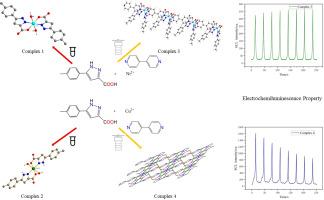Using bridging ligands to regulate pyrazole carboxylic acid coordination polymers: Investigating crystal structure and electrochemiluminescence properties
IF 4.7
2区 化学
Q2 CHEMISTRY, PHYSICAL
引用次数: 0
Abstract
In this study, we synthesized two novel coordination molecular complexes, Ni(HL)₂(H₂O)₂ (1) and Cu(HL)₂(H₂O)₂ (2), using 5-(4-methylphenyl)-1H-pyrazole-3-carboxylic acid (H2L) as the primary ligand. Structural extension using 4,4′-bipyridine linker resulted in two new complexes: [Ni(HL)₂(4,4′-bipy)]ₙ (3) and [Cu₃(L)₂(4,4′-bipy)]ₙ (4). The four crystalline materials were studied by single-crystal and powder X-ray diffraction methods. Hirshfeld surface analysis showed that hydrogen bonds dominate in the supramolecular packing. Remarkably, complexes 3 and 4 exhibited emergent electrochemiluminescence (ECL) in DMSO solutions, with complex 4 achieving high-intensity emission albeit with signal attenuation, while complex 3 demonstrated baseline stability.

用桥接配体调节吡唑羧酸配位聚合物:晶体结构和电化学发光性质的研究
本研究以5-(4-甲基苯基)- 1h -吡唑-3-羧酸(H2L)为一级配体,合成了Ni(HL) 2 (H₂O) 2(1)和Cu(HL) 2 (H₂O) 2(2)两种新型配位分子配合物。利用4,4′-联吡啶连接剂进行结构扩展,得到了两个新的配合物:[Ni(HL)₂(4,4′-bipy)]和[Cu₃(L)₂(4,4′-bipy)]。采用单晶和粉末x射线衍射方法对这四种晶体材料进行了研究。Hirshfeld表面分析表明,氢键在超分子填料中占主导地位。值得注意的是,配合物3和4在DMSO溶液中表现出紧急电化学发光(ECL),配合物4在信号衰减的情况下实现了高强度发射,而配合物3则表现出基线稳定性。
本文章由计算机程序翻译,如有差异,请以英文原文为准。
求助全文
约1分钟内获得全文
求助全文
来源期刊

Journal of Molecular Structure
化学-物理化学
CiteScore
7.10
自引率
15.80%
发文量
2384
审稿时长
45 days
期刊介绍:
The Journal of Molecular Structure is dedicated to the publication of full-length articles and review papers, providing important new structural information on all types of chemical species including:
• Stable and unstable molecules in all types of environments (vapour, molecular beam, liquid, solution, liquid crystal, solid state, matrix-isolated, surface-absorbed etc.)
• Chemical intermediates
• Molecules in excited states
• Biological molecules
• Polymers.
The methods used may include any combination of spectroscopic and non-spectroscopic techniques, for example:
• Infrared spectroscopy (mid, far, near)
• Raman spectroscopy and non-linear Raman methods (CARS, etc.)
• Electronic absorption spectroscopy
• Optical rotatory dispersion and circular dichroism
• Fluorescence and phosphorescence techniques
• Electron spectroscopies (PES, XPS), EXAFS, etc.
• Microwave spectroscopy
• Electron diffraction
• NMR and ESR spectroscopies
• Mössbauer spectroscopy
• X-ray crystallography
• Charge Density Analyses
• Computational Studies (supplementing experimental methods)
We encourage publications combining theoretical and experimental approaches. The structural insights gained by the studies should be correlated with the properties, activity and/ or reactivity of the molecule under investigation and the relevance of this molecule and its implications should be discussed.
 求助内容:
求助内容: 应助结果提醒方式:
应助结果提醒方式:


